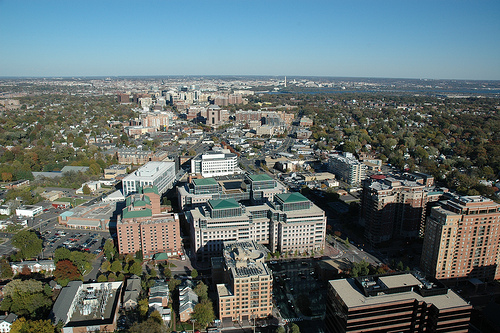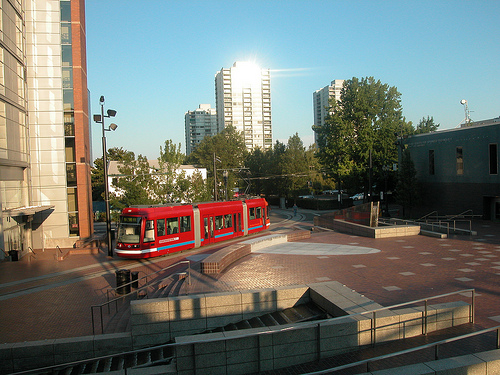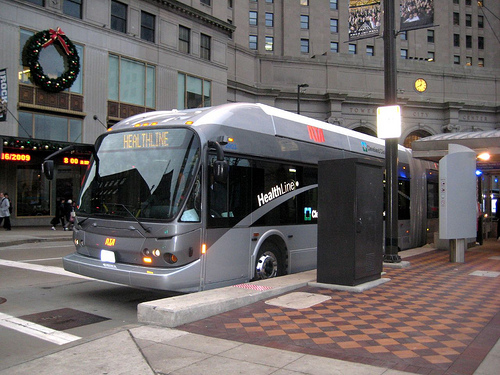This blog post shines a spotlight on 5 metro areas that are national leaders in transit-oriented development (TOD). But more importantly, this post also brings attention to the 4 key ingredients necessary to create successful TOD. Focus on these 4 ingredients and your city can succeed in creating TOD to become a more vibrant community.
National Leaders in TOD:
- Washington, DC metro area
- Portland, OR metro area
- Denver, CO metro area
- Salt Lake City, UT metro area
- Cleveland, OH metro area
Surprised to see any of these metro areas on this list? Keep reading to find out why these 5 regions are leading the nation in development along their transit systems, and how you can apply these lessons in your community. But before we explore the success of the 5 national TOD leaders, let’s define what TOD is…
What is Transit Oriented Development?
Back when I was in urban planning school, TOD was one of the most popular buzzwords. While TOD’s “buzzword status” seems to have faded in recent years, it’s actually more prevalent now than it was just a decade ago. In fact, as the benefits of TOD become more widely recognized, its potential to transform America’s urban areas will grow in coming decades.
And TOD is one of the best strategies to improve the urban vitality of your city, especially if you combine it with some of these downtown revitalization strategies. So, what exactly is TOD? According to visionary urban planner, architect, and author Peter Calthorpe:
A formula for a transit-oriented development (TOD) is very simple. Its diversity: diversity in population and in land use.
Read a more detailed explanation of Calthorpe’s TOD formula here. Another leading urbanist thinker, Kaid Benfield, author and Special Counsel for Urban Solutions at the Natural Resources Defense Council (NRDC), states that, “To make both transit and nearby neighborhoods work together, we must pay as much attention to the neighborhood as to the transit.” Read more about Benfield’s opinion on TOD here.
1. Washington, DC metro area
The entire Washington, D.C. region is a hotbed for TOD. In D.C., a new transit station was built in 2004 on the existing Metro Red Line in the NoMa (North of Massachussetts Avenue) neighborhood at a cost of $110 million. According to an article from Rachel MacCleery and Andy Stone at the Urban Land Institute, the NoMa station alone has sparked $3 billion in new development. By early 2012, the area surrounding the NoMa station had already added 7,000,000 square feet of new office, residential, hotel and retail space since 2004, with another 3,000,000 square feet of space under construction.
And the D.C. region’s TOD success is not confined within the boundaries of the District. Many of the region’s older suburban downtowns like Bethesda and Silver Spring, MD have also experienced large amounts of new development adjacent to Metro transit stations. But the Northern Virginia suburbs of D.C. (primarily Arlington County) offer the best example of TOD in the D.C. region. Arlington County used TOD to transform itself from a low-density, auto-dominated corridor into a zone of dense, walkable, mixed-use neighborhoods. It’s really a misnomer to call this area a suburb, because the county is more urban and vibrant than most of the downtown districts in the U.S.
According to a 2004 research report from the Transportation Research Board, “No place in the United States has witnessed more high-rise, mixed-use development along a rail corridor over the past three decades than Arlington County, Virginia.” From the time that Metro rail began service in the county in the 1970s until 2004, new real estate investments included: 24.4 million square feet of office space, 3.8 million square feet of retail space, 24,000 mixed-income dwelling units, and over 6,300 hotel rooms.
And the D.C. region’s strong legacy of TOD appears on track to continue. The metro area is currently building a new subway line that will connect Arlington County to Dulles International Airport in Loudoun County. This new line, the Silver Metro Line, will travel through an area that is currently dominated by suburban corporate campuses and wealthy residential districts that could soon become the next high-profile TOD zone.
2. Portland, OR metro area
Portland’s rail transit network includes 53 miles of light rail lines, 15 miles of commuter rail, and a 4-mile streetcar system. The entire system has generated a large amount of TOD throughout the Portland metro area. According to TriMet, the Portland region’s transit agency, more than $10 billion in development has taken place near Max light rail stations. But the streetcar system has provided the biggest bang for the buck.
According to a report from the City of Portland and Portland Streetcar, Inc., $3.5 billion in real estate investments were made within 2 blocks of the streetcar alignment in less than 7 years (from July 2001 to April 2008). Since the total capital cost of the streetcar line was only $103 million, the benefits of the Portland Streetcar streetcar line far outweigh the costs.
Of course, the Portland Streetcar wasn’t the only factor that led to the city’s massive urban revitalization. Rezoning, tax increment financing for public improvements, and other public policies played an important role. However, the streetcar was undoubtedly a primary enabling factor for much of Portland’s urban renaissance over the last couple decades. The streetcar’s positive effects on real estate development are most easily seen in the Pearl District, a former declining industrial district just north of downtown Portland that is now a vibrant urban neighborhood. Portland’s Pearl District is widely regarded as a national best practice model for urban revitalization.
3. Denver, CO metro area
Nearly 10 years ago (Nov. 2004), the Denver metro area’s voters decided to pony up billions of dollars to fund a massive new transit network including 122 miles of new light rail and commuter rail lines, 18 miles of new bus rapid transit lines, and a new multi-modal downtown transit terminal (Denver Union Station).
Today, the Denver region is in the midst of an unprecedented transit system expansion known as FasTracks, which will cost a total of about $6.5 billion. And the investments are really beginning to pay off in the form of TOD. According to a May 2013 article from Architect Magazine, a total of 18,000 new residential units have been built within half a mile of transit stations since the start of the program, including several thousand new downtown units.
Eric Jaffe, a regular contributor to Atlantic Cities, highlights Denver’s TOD progress in this article. Jaffe points out that “Denver’s recent success is encouraging for all U.S. metros, largely because the city followed a typical path in the 20th century.” Denver’s population density declined from 1950 until 1990, going from 4,741 residents/square mile to 3,309. However, the city’s development patterns shifted in the mid-1990s and population density has risen by nearly 25% up to about 4,000 people/square mile, thanks in large part to region’s transit investments and success in TOD.
4. Salt Lake City, UT metro area
This video highlights the Salt Lake City region’s ambitious transit expansion program.
The Salt Lake City region is a very interesting example of how TOD can become successful. Like the Denver region, the Salt Lake City metro area is the main center of population in a politically conservative state, perhaps even more so than Colorado. Despite this political climate, which is usually associated with pro-highway and anti-transit sentiments, the Salt Lake region recently completed a $2.5 billion transit system expansion.
This transit expansion, named FrontLines 2015, added 70 miles of new rail lines – 26 miles of new light rail and 44 miles of new commuter rail – to the region’s existing 64-mile system in just 5 years. Even more impressive is the fact that the FrontLines 2015 project was completed 2 years ahead of schedule and for $300 million under budget.
So far, the Salt Lake metro area has not yet seen a huge amount of TOD yet, other than within downtown Salt Lake City, but I chose to include it in this post as a leader in TOD because of where the region is trending. In many ways, the Salt Lake City region is following in the footsteps of the Denver metro area. And although the Salt Lake metro began expanding its rail system a bit later than Denver did, it has caught up in a hurry.
As noted in Streetsblog by Carolyn Szczepanski, Salt Lake City is investing more, per capita, in new public transit than any other metro area in the country. And as Angie Schmitt observed in another Streetsblog post in 2013, Salt Lake “was the only city in the country building light rail, bus rapid transit, streetcars and commuter rail at the same time.”
And these investments are being complemented with proactive public policies like zoning amendments and TOD plans that will encourage dense, mixed-use development along the region’s growing rail system. Given the metro area’s success in creating a robust regional rail system, we can only assume that Salt Lake will soon become a national model for TOD, especially if the region realizes its projections of a population growth rate of 65% by 2040 (adding nearly 1.5 million new residents).
5. Cleveland, OH metro area
Cleveland’s TOD success is remarkable for two reasons. First, it proves that you don’t need a booming regional economy for TOD to work. The Cleveland metro area is one of the few regions in the U.S. with a declining population. The region lost 85,000 residents between 2000 and 2012. And the City of Cleveland itself has lost residents each decade since 1950, though it appears that the decline has slowed down to a trickle since 2010.
Second, the Cleveland TOD example is not even based on a new rail line. The Health Line corridor is a Bus Rapid Transit (BRT) line. This proves that if you build a high-quality BRT line, you can achieve the same level of success as a similar light rail line.
Up until now, it was assumed that BRT was not capable of generating TOD in the U.S. and that only foreign BRT systems (like the ones in Brasilia, Brazil or Bogota, Colombia) could lead to a significant amount of new real estate development. However, this was largely because the BRT systems implemented in the U.S. were half-hearted versions of BRT…until the Health Line.
The Cleveland HealthLine BRT project was completed in 2008 along Euclid Avenue. In less than 6 years since opening, this corridor has seen an incredible $5.8 billion in new development, thanks in large part to the BRT line. Given the HealthLine’s $200 million total cost, this is by far the biggest dollar-for-dollar impact from a BRT line in the U.S. The HealthLine project is also significant because it gives a new hope for the dozens of cities that are currently implementing or planning BRT systems that they can create TOD without having to rely only on rail investments.
Lessons Learned
What’s the point of highlighting these national leaders in TOD? It isn’t just to congratulate them on their success, though they certainly deserve it. The purpose of this post is to learn how these cities have become models of TOD.
Here are the 4 key ingredients needed to create successful transit oriented development:
- TOD Ingredient #1: Connect dense employment centers
- TOD Ingredient #2: Regional collaboration
- TOD Ingredient #3: Proactive planning and public policies to encourage TOD
- TOD Ingredient #4: Public-private partnerships for joint development
TOD Ingredient #1: Connect dense employment centers
A research paper from the Center for Transit Oriented Development (CTOD) makes the following conclusion about TOD:
Real estate development is more likely to occur in station areas that are within close proximity to major employment centers. Therefore, if transit is planned in a way that makes strong connections to significant employment centers, it can also promote residential TOD in places on the transit corridor where commercial uses are less likely to locate. Understanding this relationship between employment centers and residential TOD is an important part of the TOD equation.
The findings from this research are important for cities that are considering building a new transit line. First and foremost, new transit lines must serve the region’s downtown since this is almost always the biggest center of employment in the region. And the transit line should ideally connect downtown to the region’s second largest employment center, or at least one of the region’s top five clusters of employment.
This opens up a plethora of opportunities for new residential development along the new transit line, because people who work in either of the two major employment centers can now live any where along the transit line and commute to work without needing an automobile. If you don’t connect your downtown to another dense cluster of jobs, you will miss out on many of the opportunities for TOD.
TOD Ingredient #2: Regional collaboration
Denver and Salt Lake City are both great examples regional collaboration for TOD. In each case, the largest metro area in a state with a conservative-leaning political constituency was able to get dozens of individual cities and counties to agree to a plan to tax themselves to the tune of several billion dollars for the creation of a new regional transit system. That’s pretty impressive.
This ingredient gets at the heart of how urban areas actually function. Although we often focus on individual cities (largely because of political boundaries), it is the metro area that really matters. Economies function at the regional level. Labor markets and housing markets function at the level of the metro area, not the individual cities. Transit systems work at the regional level.
Most fundamentally, people live their lives within metro areas, often living in one city, working in another city, shopping in another city, and finding entertainment in yet another city, all within the same urban region. For TOD to work, these realities must be taken into account when planning and implementing regional transit investments.
TOD Ingredient #3: Proactive planning and public policies to encourage TOD
The Institute for Transportation and Development Policy (ITDP) issued a report in late 2013 that analyzed 21 North American transit corridors to determine what makes TOD happen. The report considered three major factors for TOD success: government intervention, land potential, and transit quality.
To the surprise of many, the report found that the quality of the transit investment is the least important indicator of success, while government support for TOD is the strongest predictor of success. The strength of the land market around the transit corridor is the second most important factor for success.
Eric Jaffe summarized the ITDP report in this Atlantic Cities article. Here’s Jaffe’s take on what cities should do to encourage TOD:
The basic takeaway is that cities seeking TOD investments should build that desire around a strong plan for government intervention first and foremost, then identify a corridor with great potential as a secondary act. The type or quality of the transit system itself need only be a third consideration.
TOD Ingredient #4: Public-private partnerships for joint development
Public-private partnerships have received an increasing amount of attention over the last decade or two in the realms of economic development and urban planning. TOD is one of the best examples of the importance of partnerships between government and the private sector.
The essence of TOD is to make a public investment in a new transit line that leverages a much greater amount of corresponding private sector investment along that transit line. And while the concept is quite simple at its core – make a public investment to stimulate private investment – it requires a lot of work and cooperation from both sides to maximize the benefits for government and business.
It’s quite fitting then that the metro area which holds the headquarters of our nation’s government – Washington, D.C. – is perhaps the nation’s best example of public-private partnerships for TOD. A report on TOD case studies from Reconnecting America states that the D.C. metro area “is, by far, the nation’s leader in transit joint development” with about 30 examples of joint development.
Bottom Line
These 5 metro areas are by no means the only ones that are benefiting from transit oriented development…dozens of communities are taking advantage of TOD to improve their urban vitality. But what makes these 5 regions such great examples is this: If you focus on the 4 TOD ingredients listed above, you can make transit oriented development succeed in your community regardless of:
- Your community’s political climate. TOD exists in “red” states and “blue” states.
- The type of transit system. TOD has proven successful with light rail, heavy rail, commuter rail, streetcar, and bus rapid transit (BRT).
- The state of your regional economy. TOD exists in high-growth regions and in declining regions.
What’s your city doing to create transit oriented development?









[…] Scale has interesting case studies of successful transit-oriented development around the country, listing Washington DC, Portland, […]